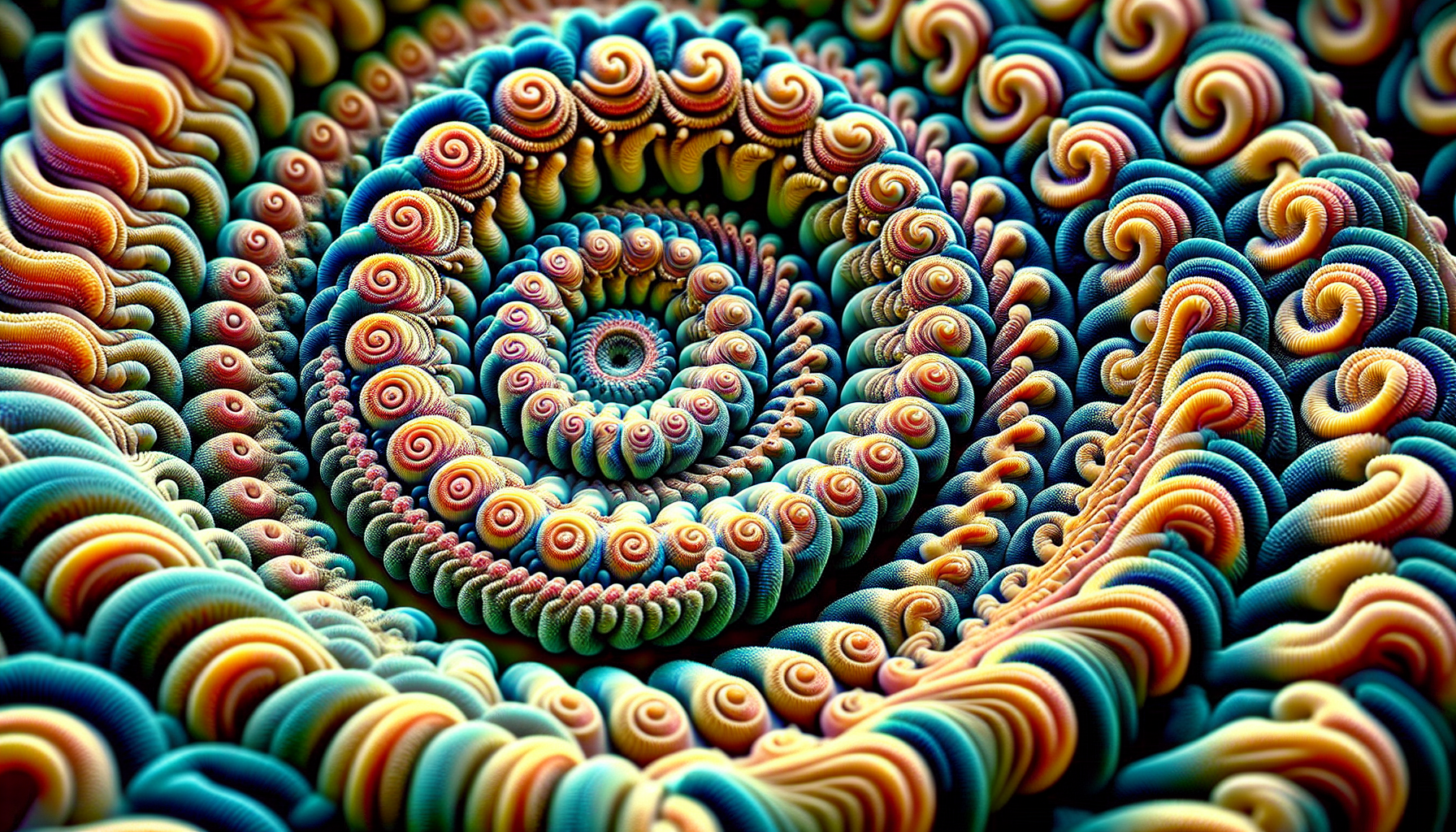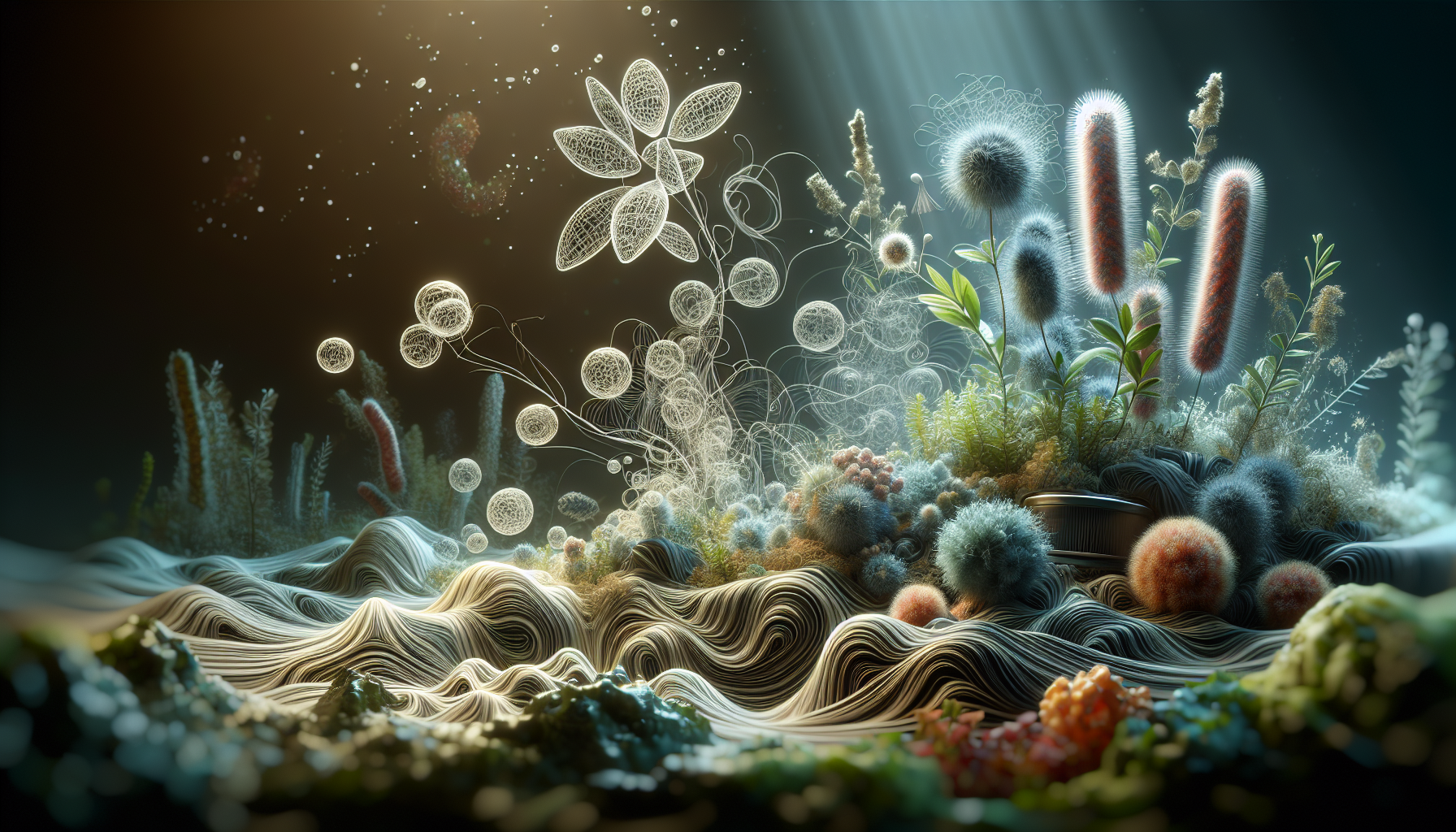In the realm of nature’s artistry, we often find ourselves captivated by the grandeur of sprawling landscapes, the vibrant hues of a sunset, or the delicate intricacies of a butterfly’s wings. Yet, beneath our very noses lies a universe of design so minute and mesmerizing that it often escapes our everyday notice. Welcome to the world of bacterial swirl designs—a microcosm of elegance and complexity that rivals even the most celebrated works of art. As we embark on this journey to discover the intricate beauty of these microbial masterpieces, prepare to be enchanted by the patterns and structures that, despite their microscopic scale, echo the grand artistry found in the vast expanse of the cosmos.
Bacteria, often dismissed as mere germs or pathogens, play a pivotal role in crafting these stunning natural designs. Through their interactions, movements, and growth patterns, bacteria create swirling formations that are not only visually captivating but also scientifically significant. Imagine a living canvas where cells move and multiply, painting dynamic, ever-evolving patterns that are influenced by environmental conditions, genetic predispositions, and chemical interactions. These bacterial swirls are more than just beautiful; they are a testament to the complexity and intelligence inherent in nature’s tiniest architects. As we delve deeper into this topic, we’ll explore the science behind these formations, the factors influencing their development, and the potential applications they hold for fields ranging from medicine to environmental science.
Throughout this article, we will unravel the mysteries of bacterial swirls by examining the principles of bacterial motility and the environmental factors that drive these formations. We’ll discuss how researchers are harnessing the power of these natural designs to innovate and solve real-world problems, and we’ll consider the philosophical implications of finding such artistry in the microscopic world. From the lab to the art gallery, bacterial swirls are gaining recognition as both scientific phenomena and sources of inspiration. Join us as we unveil nature’s hidden masterpieces, fostering a newfound appreciation for the microscopic wonders that contribute to the grand tapestry of life. 🌿🔬
The Fascinating World of Bacterial Swirl Designs
Bacteria are among the most fascinating microorganisms on our planet, playing critical roles in ecosystems, human health, and even technological innovations. However, one of their less known but equally captivating roles is in the creation of intricate designs known as bacterial swirls. These naturally occurring patterns have fascinated scientists and artists alike, offering a glimpse into the hidden beauty of the microscopic world. In this section, we will explore what bacterial swirl designs are, how they form, and the underlying principles that guide their creation.
Bacterial swirls are essentially patterns formed by the movement and growth of bacterial colonies. When observed under a microscope, these designs resemble intricate artworks with swirling patterns, circles, and lines. The complexity of these designs arises from the interplay of various biological processes, including chemotaxis (movement in response to chemical stimuli), quorum sensing (a system of stimuli and response correlated to population density), and motility. The study of these patterns is not only important for understanding bacterial behavior but also offers insights into the fundamental principles of self-organization in biological systems.
The Science Behind Bacterial Swirl Patterns
The formation of bacterial swirl patterns is a complex process driven by several biological mechanisms. One key factor is the bacterial cell’s ability to move. Many bacteria have flagella, tail-like structures that rotate, propelling the bacteria through their environment. This movement is not random; bacteria use a process called chemotaxis to navigate toward favorable conditions or away from harmful substances. Chemotaxis involves receptors that detect chemical gradients, allowing bacteria to move toward nutrients or away from toxins.
Another crucial mechanism in the formation of bacterial swirls is quorum sensing. This is a form of communication that allows bacteria to detect and respond to changes in population density. When bacteria reach a certain density, they release signaling molecules that trigger changes in gene expression. This coordinated behavior can lead to changes in movement and growth patterns, contributing to the intricate designs observed in bacterial swirls.
Motility, the ability to move spontaneously and actively, is also a critical component. In addition to flagella-driven movement, some bacteria can glide or twitch, using pili or other surface structures. This diversity in motility types contributes to the variety of patterns that bacterial colonies can form. Understanding these mechanisms is essential for scientists who seek to harness bacterial swirls for practical applications, such as biosensing or materials science.
Exploring the Artistic and Practical Applications
Beyond their scientific intrigue, bacterial swirls have captured the imagination of artists and designers. The natural beauty and complexity of these patterns offer a source of inspiration for creating artwork and designs that mimic nature’s intricacies. Some artists have even collaborated with scientists to cultivate bacterial swirls as living art pieces, blurring the lines between biology and art.
The artistic appeal of bacterial swirls lies in their unpredictable and organic nature. Unlike traditional art forms, where the artist controls every aspect of the creation, bacterial swirls involve an element of chance and spontaneity. This makes each pattern unique and unrepeatable, much like a fingerprint. Artists can influence the process by selecting specific bacterial strains and growth conditions, but the final design is ultimately shaped by the bacteria themselves.
In addition to their aesthetic value, bacterial swirls hold promise for practical applications. Researchers are exploring ways to harness these patterns for use in biosensing, where bacterial swirls could be used to detect environmental changes or contaminants. The principles of self-organization observed in bacterial swirls could also inform the design of new materials and systems, leading to innovations in nanotechnology and bioengineering.
Challenges and Opportunities in Harnessing Bacterial Swirls
While the potential applications of bacterial swirls are exciting, there are several challenges that must be addressed. One major challenge is controlling the formation of bacterial swirls to achieve desired outcomes. This requires a deep understanding of the factors that influence bacterial behavior and the ability to manipulate these factors precisely. Advances in genetic engineering and synthetic biology may provide tools to overcome this challenge, allowing researchers to engineer bacteria with specific properties for creating custom patterns.
Another challenge is the scalability of bacterial swirls for practical applications. While it is possible to create intricate designs in a laboratory setting, scaling these processes for industrial or commercial use poses significant technical and logistical hurdles. Researchers must find ways to maintain the integrity and functionality of bacterial swirls on a larger scale, which may involve developing new cultivation techniques or bioreactors.
Despite these challenges, the opportunities for harnessing bacterial swirls are vast. As our understanding of microbial ecology and genetics continues to grow, so too will our ability to exploit the unique properties of bacterial swirls for a wide range of applications. Whether used for artistic expression or technological innovation, bacterial swirls offer a window into the hidden beauty of the microbial world and a testament to the ingenuity of nature.
Comparative Analysis of Bacterial Swirl Patterns
To appreciate the diversity and complexity of bacterial swirl patterns, it is useful to compare the characteristics of different types of bacteria and the patterns they produce. Below is a comparative table that highlights some key differences between bacterial species and their corresponding swirl designs.
| Bacterial Species | Motility Type | Typical Swirl Pattern | Environmental Influence |
|---|---|---|---|
| Pseudomonas aeruginosa | Flagella-driven | Radial swirls | Temperature and nutrient concentration |
| Myxococcus xanthus | Gliding | Wave-like patterns | Surface texture and moisture levels |
| Escherichia coli | Flagella-driven | Concentric rings | pH and nutrient availability |
As demonstrated in the table above, different bacterial species exhibit varying motility types and produce distinct swirl patterns. These patterns are influenced by a variety of environmental factors, highlighting the importance of context in the study of bacterial swirls.
Case Study: Harnessing Bacterial Swirls for Biosensing
One promising application of bacterial swirls is in the field of biosensing. Researchers are exploring the use of bacterial swirls as sensitive indicators of environmental changes. By engineering bacteria to produce specific patterns in response to certain stimuli, it is possible to create living sensors that can detect pollutants, toxins, or changes in environmental conditions.
For example, scientists have developed bacterial strains that produce distinct swirl patterns in the presence of heavy metals. These patterns can be visually observed or detected using imaging techniques, providing a rapid and cost-effective method for monitoring environmental contamination. The use of bacterial swirls in biosensing represents a novel approach to environmental monitoring, combining the sensitivity and specificity of living systems with the elegance of natural patterns.
If you want to learn more about how bacterial swirls are being used in biosensing, I recommend watching the video “Biosensing with Bacterial Swirls” by Science Daily. This video provides an overview of the latest research in this exciting field.
As we continue to explore the potential of bacterial swirls, it is clear that these natural patterns offer much more than aesthetic appeal. They represent a unique convergence of art and science, biology and technology, offering endless possibilities for innovation and discovery.
For those interested in further exploring the beauty and complexity of bacterial swirl designs, I highly recommend checking out related resources and videos. One such video, “The Art of Bacteria” by Microbial Art, showcases stunning visuals of bacterial patterns and provides insights into the processes behind their creation.
- Learn about the diversity of bacterial species and their motility types.
- Explore the potential applications of bacterial swirl patterns in technology and art.
- Understand the challenges and opportunities in harnessing bacterial swirls for practical use.
- Discover the intricate interplay of biological mechanisms that drive pattern formation.
The study of bacterial swirls is a testament to the complexity and beauty of nature’s designs. It is a field that continues to evolve, offering new insights and opportunities for those willing to look beyond the surface and into the microscopic world.

Conclusion
Exploring the intricate beauty of bacterial swirl designs has truly unveiled nature’s masterpieces in a manner that captivates both the scientific community and art enthusiasts alike. Throughout this article, we delved into the mesmerizing patterns formed by bacterial colonies, uncovering the processes and factors that contribute to these breathtaking formations. We examined how variations in bacterial species, growth conditions, and environmental factors lead to an astonishing diversity of designs, from concentric circles to elaborate fractal patterns.
One of the key points discussed was the role of bacterial motility and chemotaxis in creating these swirl designs. The ability of bacteria to move and respond to chemical stimuli results in the dynamic formation of patterns, demonstrating not only the complexity of bacterial behavior but also the elegance of their self-organizing capabilities. This aspect highlights the intersection of biology and physics, as principles of fluid dynamics and mathematical models are essential in understanding and predicting these formations.
Furthermore, we explored the implications of these bacterial patterns beyond their aesthetic appeal. The study of these natural designs offers insights into microbial ecology, providing clues about bacterial interactions and adaptations in various environments. Such knowledge is invaluable in fields like medicine and environmental science, where understanding bacterial behavior can lead to advancements in antibiotic development and pollution management.
The significance of appreciating bacterial swirl designs extends to their potential applications in technology and art. The unique properties of these natural formations have inspired innovations in material science, where bacterial patterning techniques are being explored for fabricating biomaterials and sensors. Additionally, artists and designers are drawing inspiration from these natural masterpieces, integrating them into creative expressions that blur the line between science and art.
In reinforcing the importance of this topic, it is crucial to recognize how these bacterial patterns symbolize the intricate interconnectedness of life. They serve as a reminder of the hidden beauty and complexity that exists within the microscopic world, often overlooked in our everyday lives. By unveiling these patterns, we not only enhance our understanding of nature but also foster a deeper appreciation for the unseen wonders that shape our world.
As you reflect on the fascinating journey through the world of bacterial swirl designs, I encourage you to take this knowledge and share it with others. Discuss these captivating phenomena with friends and colleagues, and consider how the principles observed in bacterial behavior might apply to broader contexts in your field of interest. Engage in conversations that bridge the gap between science and art, fostering a community of curiosity and innovation.
I also invite you to explore further research on this topic through reputable sources such as Nature and ScienceDirect, where you can find in-depth studies and articles that continue to unravel the mysteries of bacterial behavior and design.
In conclusion, the exploration of bacterial swirl designs is not merely an academic pursuit but a journey into the heart of nature’s artistry. By embracing these natural wonders, we open ourselves to a world of inspiration and discovery, where the seemingly mundane becomes a canvas for the extraordinary. Let us celebrate the beauty of these microbial masterpieces and carry forward the insights they offer, inspiring creativity and innovation in all facets of life. 🌿🔬
Toni Santos is a visual explorer and microscopic storyteller who delves into the hidden aesthetics of microbial life. Through a fusion of scientific curiosity and artistic insight, Toni transforms the overlooked world of bacteria, fungi, and cellular forms into mesmerizing visual narratives—revealing the elegance, symmetry, and chaos that thrive at microscopic scales.
Rooted in a fascination with life forms too small to see yet too intricate to ignore, Toni’s work captures the bizarre beauty of microbial colonies, biofilms, and spore patterns. These images aren’t just representations—they are celebrations of the artistic intelligence encoded in nature’s tiniest architects.
With a background in visual design and bio-inspiration, Toni merges scientific imaging techniques with creative expression, transforming petri dish cultures, fluorescence microscopy, and microbial textures into works that provoke both wonder and contemplation.
As the creative force behind Vizovex, Toni offers curated visual studies, microbial-inspired designs, and essays that bridge art and microbiology—inviting viewers to reimagine what beauty means at the edge of perception.
His work is a tribute to:
The hidden geometries of living systems
The surprising elegance of microbial growth
The role of micro-life in shaping visual culture
Whether you’re a scientist, artist, or simply curious about the unseen world that sustains us, Toni opens a window into a universe where life writes poetry in colonies and patterns, one microbe, one frame, one breathtaking detail at a time.





